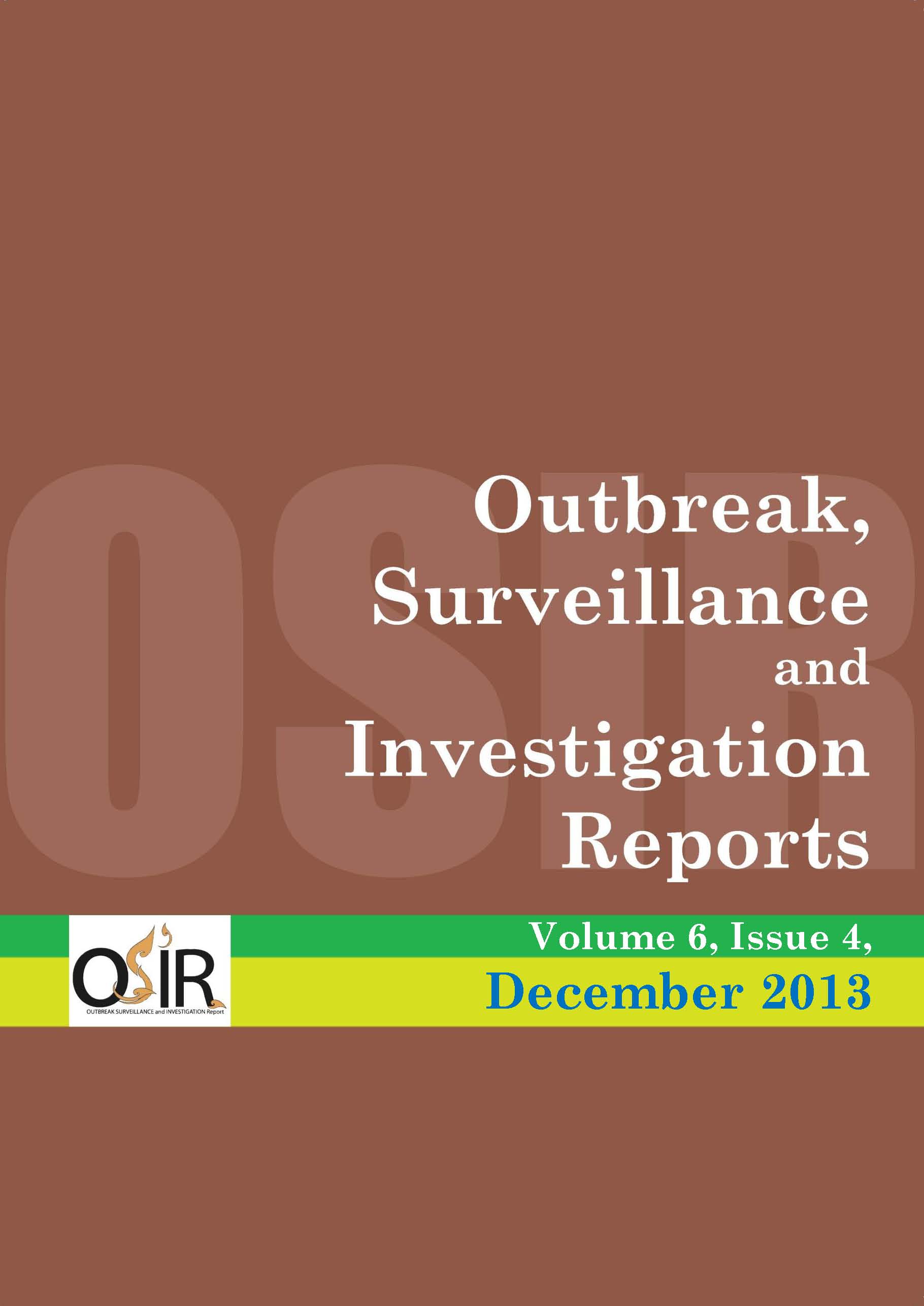Estimation of Acute Diarrhea and Acute Respiratory Infections among Children under Five Years Who Lived in a Peri-urban Environment of Myanmar
DOI:
https://doi.org/10.59096/osir.v6i4.263299Keywords:
acute diarrhea, acute respiratory infections, dual burden, under five children, environmental contaminantsAbstract
Exposures to multiple environmental contaminants place children under five years of age at a greater risk to acute diarrhea and acute respiratory tract infections (ARI). To assess this phenomenon, a cross-sectional survey was conducted to examine relationships between environmental conditions and occurrence of acute diarrhea and ARI in peri-urban areas of Yangon Region, Myanmar. Mothers or caretakers of 620 children under five years were interviewed using a structured questionnaire. Of these children, 1.0% had acute diarrhea, 45% had ARI and 3.7% had both conditions during last four weeks. Children aged 24-59 months (OR=2.1, 95% CI=0.7-6.5) were more likely to suffer from acute diarrhea and ARI than infants. Bivariate analyses revealed significant associations between attack rate of acute diarrhea and living in a bamboo house, storage of drinking water in a clay pot, using a cloth filter for drinking water and unsafe method of garbage disposal. In addition, significant associations were identified between ARI attack rate and presence of smoke around the house. Multivariate analyses also identified significantly association for acute diarrhea and living in a bamboo house and unsafe waste disposal. Integrated community-based strategies on environmental conditions, water, sanitation and hygiene could reduce the dual burden of these illnesses in children under five years of age.
References
World Health Organization. Strategy for coordinated approach to prevention and control of acute diarrhoea and respiratory infection in the South-East Asia Region. 2010. [cited 2013 Feb 4]. <http://www.searo.who.int/entity/emerging_diseases/documents/SEA_CD_212/en/index.html>
World Health Organization, United Nations Children's Fund. Five-year strategic plan for child health development in Myanmar (2010-2014). 2011. [cited 2013 Feb 4].
Briggs D. Making a difference: indicators to improve children’s environmental health. Geneva: World Health Organization; 2003. [cited 2013 Feb 4]. <http://www.who.int/phe/children/en/cehindicsum.pdf>
Schmidt WP, Cairncross S, Barreto ML, Clasen T, Genser B. Recent diarrhoeal illness and risk of lower respiratory infections in children under the age of 5 years. Int J Epidemiol. 2009 Jun;38(3):766-72. Epub 2009 Mar 11. [cited 2013 Feb 4]. <http://ije.oxfordjournals.org/content/38/3/766.long>
Ghimire M, Pradhan YV, Maskey MK. Community-based interventions for diarrhoeal diseases and acute respiratory infections in Nepal. Bull World Health Organ. 2010 Mar;88(3):216-21. [cited 2013 Feb 4]. <http://www.ncbi.nlm.nih.gov/pmc/articles/PMC2828786/>
Prüss-Ustün A, Bonjour S, Corvalán C. The impact of the environment on health by country: a meta-synthesis. Environ Health. 2008 Feb 25;7:7. [cited 2013 Feb 4]. <http://www.ehjournal.net/content/7/1/7>
Wai KT, Htun PT, Oo T, Myint H, Lin Z, Kroeger A, et al. Community-centred eco-bio-social approach to control dengue vectors: an intervention study from Myanmar. Pathog Glob Health. 2012 Dec;106(8):461-8.
International Institute for Population Sciences, ORC Macro. National Family Health Survey (NFHS-2), 1998-99. Mumbai: International Institute for Population Sciences; 2000 Oct. p. 216-20. [cited 2013 Feb 4]. <http://www.measuredhs.com/pubs/pdf/FRIND2/FRIND2.pdf >
Gupta N, Jain SK, Ratnesh, Chawla U, Hossain S, Venkatesh S. An evaluation of diarrheal diseases and acute respiratory infections control programmes in a Delhi slum. Indian J Pediatr. 2007 May;74(5):471-6. [cited 2013 Feb 4].<http://www.medind.nic.in/icb/t07/i5/icbt07i5p471.pdf>
Chaudhari VP, Srivastava RK, Moitra M, Desai VK. Domestic environment and morbidity of under five children. The Internet Journal of Epidemiology. 2009;7:1.
Bbaale E. Determinants of diarrhea and acute respiratory infection among under-fives in Uganda. Australas Med J. 2011;4(7):400-9. Epub 2011 Jul 31.
Myanmar. Department of Health. Ministry of Health. Diarrheal diseases control programme: annual report. Nay Pyi Taw: Department of Health; 2010.
Ngnikam E, Mougoué B, Feumba R, Noumba I, Tabue G, Meli J. Water, wastes, and children’s health in low-income neighborhoods of Yaoundé. In: Charron DF, editor. Ecohealth research in practice: innovative applications of an ecosystem approach to health. Ottawa: International Development Research Centre; 2012. [cited 2013 Feb 4]. <http://idl-bnc.idrc.ca/dspace/bitstream/10625/47809/1/IDL-47809.pdf>
Downloads
Published
How to Cite
Issue
Section
License
Copyright (c) 2023 Outbreak, Surveillance, Investigation & Response (OSIR) Journal

This work is licensed under a Creative Commons Attribution-NonCommercial-NoDerivatives 4.0 International License.








